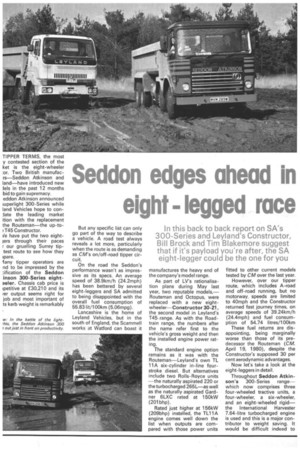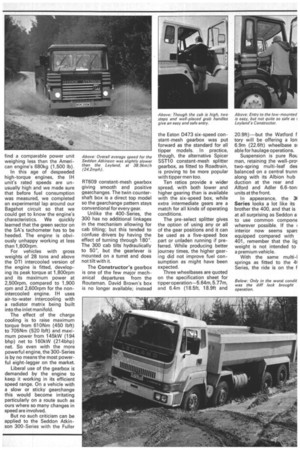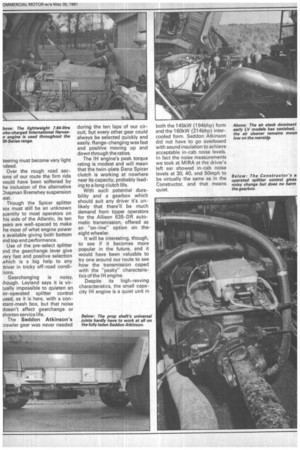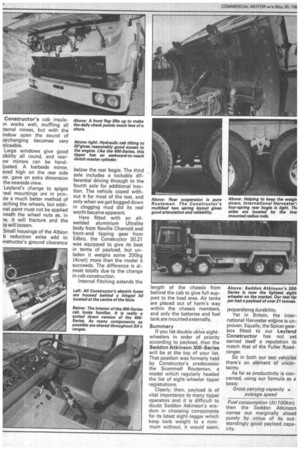Seddon edges ahead in eight legged race
Page 48

Page 49

Page 50

Page 51

Page 52

If you've noticed an error in this article please click here to report it so we can fix it.
TIPPER TERMS, the most y contested section of the ket is the eight-wheeler :or. Two British manufacrs—Seddon Atkinson and land—have introduced new leis in the past 12 months bid to gain supremacy.
eddon Atkinson announced >uperlight 300-Series while land Vehicles hope to condate the leading market ition with the replacement the Routeman—the up-to: T45 Constructor.
Ve have put the two eightlers through their paces r our gruelling Surrey tiptest route to see how they 'pare.
any tipper operators are nd to be impressed by the 3ification of the Seddon inson 300-Series eightaeler. Chassis cab price is ipetitive at £30,210 and its ter output seems right for job and most important of ts kerb weight is remarkably But any specific list can only go part of the way to describe a vehicle. A road test always reveals a lot more, particularly when the route is as demanding as CM's on/off-road tipper circuit.
On the road the Seddon's performance wasn't as impressive as its specs. An average speed of 38.9km/h (24.2mph) has been bettered by several eight-leggers and SA admitted to being disappointed with the overall fuel consumption of 55.83 lit/100km (5.06mpg).
Lancashire is the home of Leyland Vehicles, but in the south of England, the Scammell works at Watford can boast it manufactures the heavy end of the company's model range.
As part of LV's rationalisation plans during May last year, two reputable models,— Routeman and Octopus, were replaced with a new eightwheeler—Constructor 30-21, the second model in Leyland's T45--range. As with the Roadtrain range, the numbers after the name refer first to the vehicle's gross weight and then the installed engine power rating.
The standard engine option remains as it was with the Routeman—Leyland's own TL 11A six-cylinder in-line fourstroke diesel. But alternatives include two Rolls-Royce units the naturally aspirated 220 or the turbocharged 265L—as well as the naturally aspirated Gardner 6LXC rated at 150kW (201 bhp).
Rated just higher at 156kW (209bhp) installed, the TL11A engine comes well down the list when outputs are compared with those power units fitted to other current models tested by CM over the last year.
However, over our tipper route, which includes A-road and off-road running, but no motorway, speeds are limited to 40mph and the Constructor returned fast journey times, on average speeds of 39.24km/h (24.4mph) and fuel consumption of 54.74 litres/100km These fuel returns are disappointing, being marginally worse than those of its predecessor the Routeman (CM, April 19, 1980), despite the Constructor's supposed 30 per cent aerodynamic advantages.
Now let's take a look at the eight-leggers in detail.
Throughout Seddon Atkinson's 300-Series range— which now comprises three four-wheeled tractive units, a four-wheeler, a six-wheeler, and an eight-wheeled rigid— the International Harvester 7.64-litre turbocharged engine is used and this is a major contributor to weight saving. It would be difficult indeed to find a comparable power unit weighing less than the American engine's 680kg (1,500 lb).
In this age of despeeded high-torque engines, the 1H units rated speeds are unusually high and we made sure that before fuel consumption was measured, we completed an experimental lap around our Bagshot circuit so that we could get to know the engine's characteristics. We quickly learned that the green sector on the SA's tachometer has to be heeded. The engine is obviously unhappy working at less than 1,60Orpm.
For vehicles with gross weights of 28 tons and above the DTI intercooled version of the engine is fitted, developing its peak torque at 1,800rom and its maximum power at 2,500rpm, compared to 1,900 rpm and 2,600rpm for the nonintercooled engine. IH uses air-to-water intercooling with a radiator matrix being built into the inlet manifold.
The effect of the charge cooling is to raise maximum torque from 610Nm (450 lbft) to 705Nm (520 lbft) and maximum power from 145kW (194 bhp) net to 160kW (214bhp) net. So even with the more powerful engine, the 300-Series is by no means-the most powerful eight-legger on the market.
Liberal use of the gearbox is demanded by the engine to keep it working in its efficient speed range. On a vehicle with a slow or sticky gearchange this would become irritating particularly on a route such as ours where so many changes in speed are involved.
But no such criticism can be applied to the Seddon Atkinson 300-Series with the Fuller RT609 constant-mesh gearbox giving smooth and positive gearchanges. The twin countershaft box is a direct top model so the gearchange pattern stays conventional for every gear.
Unlike the 400-Series, the 300 has no additional linkages in the mechanism allowing for cab tilting; but this tended to confuse drivers by having the effect of turning through 180°. The 300 cab tilts. hydraulically to 50°, but the gearlever is mounted on a turret and does not tilt with it.
The Constructor's gearbox is one of the few major mechanical departures from the Routeman. David Brown's box is no longer available; instead the Eaton 0473 six-speed constant-mesh gearbox was put forward as the standard for all tipper models. . In practice, though, the alternative Spicer SST10 constant-mesh splitter gearbox, as fitted to Roadtrain, is proving to be more popular with tipper men too.
Ten ratios provide a wider spread, with both lower and higher gearing than is available with the six-speed box, while extra intermediate gears are a match for all kinds of operating conditions.
The pre-select splitter gives the option of using any or all of the gear positions and it can be used as a five-speed box part or unladen running if preferred. While producing better journey times, the higher gearing did not improve fuel consumption as might have been expected.
Three wheelbases are quoted on the specification sheet for tipper operation-5.64m, 5.77m, and 6.4m (18.5ft, 18.9ft and 20.9ft)—but the Watford f tory will be offering a Ion 6.9m (22.6ft) wheelbase si able for haulage operations.
Suspension is pure Rou man, retaining the well-prom two-spring multi-leaf des balanced on a central trunn along with its Albion hub duction at the rear and Alford and Adler 6.6-toni units at the front.
In appearance, the 34 Series looks a lot like its brother the 400, and that is at all surprising as Seddon a to use common compone wherever possible. If the interior now seems spars equipped compared with 401, remember that the lig weight is not intended to a premium vehicle.
With the same multi-I springs as fitted to the 41 Series, the ride is on the f but not unduly harsh. regular off-road use, an Jstable suspension seat Id be preferable to the Cox t currently used—but the was not at all uncomfort).
'he action of the purely raulically operated clutch eavy but this is only notice) when the pedal has to be 1 down for long periods—in fie, for example.
.45 is synonymous with the e-styled C40 all steel tilt and as fitted to the Conictor full-width construcI provides a roomy interior a sensible balance betmi high trim specification practicability.
he two-tone grey colour eme gives a degree of lights to the cab interior, while a k tranverse ribbed black ber floor covering looks i-wearing and allows easy 11lowing for the height of cab floor, entry to the drivseat is particularly good. door pulls are neatly deied into the panel's edge within easy reach. Wide, deep and staggered steps give a sure purchase to muddy boots, while grab handles placed either side of the door opening make the climb even safer.
As standard, the Cox drivers seat, covered in a washable material, is non-suspension but provides ample adjustment both longtitudinally and vertically, while the backrest can be tilted. The steering column too can be made to pivot back towards the driver, giving a more inclined angle to the small steering wheel.
T45-type instrumentation comprises six gauges, tachometer and tachograph, and is clustered together directly ahead of the driving seat.
If one juggles with the three variables a tipper operator is most concerned with—carrying capacity, average speed and fuel consumption to produce a
-productivity factorthe 300-Series still comes out
ahead of the Constructor. And the list price of the Seddon is some €3,700 less.
An exceptionally good payload is the 300-Series forte, and this is the reason for its high productivity rating.
As mentioned earlier, with the Seddon it's important to keep the revs well up in the green sector of the rev counter for maximum efficiency. On our particular vehicle, if the revs dropped too low a trace of black smoke from the exhaust was noticeable.
But we soon discovered that there was an even stronger incentive to keep the motor spinning reasonably fast. It was simply that the steering's power assistance became ineffective at an engine speed below about 1,400rpm.
Without power assistance, the fully laden 30-tonner's twinsteered axles are very difficult to turn, as you might imagine, and after being caught out once or twice negotiating roundabouts we learned our lesson and made sure from then on that we were in a sufficiently low gear to keep the revs high before beginning a manoeuvre.
For a driver who is aware of this quirk, it is no more than an irritant; but for a driver unused to the vehicle, or in an emergency, this failing of power assistance could be dangerous. Perhaps Seddon Atkinson should change the power steering pump to one that has enough capacity to give power assistance even at low engine speeds.
Moreover the SA's doesn't offer much of a turning circle. No eight-wheeler can turn on a sixpence but our measurements confirmed that the 300 needed some 4m (13ft) more on full lock to turn around than the Constructor.
Indeed, to begin with, the Constructor's steering seemed much too light, but we became more and more in tune with it. By the time we began ploughing through the clogging mud on the off-road section of CM's route we really began to appreciate its advantage.
There was no chance to drive the vehicle empty but one can imagine that when the front bogie loading is reduced by more than five tonnes, the teering must become very light ideed.
Over the rough road secions of our route the firm ride vould have been softened by he inclusion of the alternative 3hapman Bremshey suspension ,eat.
Though the Spicer splitter )ox must still be an unknown wantity to most operators on his side of the Atlantic, its ten 3ears are well-spaced to make he most of what engine power s available giving both bottom Ind top end performance.
Use of the pre-select splitter lnd the gearchange lever give zery fast and positive selection Nhich is a big help to any driver in tricky off-road conditions.
Gearchanging is noisy, though. Leyland says it is virtually impossible to quieten an sir-operated splitter control used, as it is here, with a constant-mesh box, but that noise doesn't affect gearchange or shorten service life.
The Seddon Atkinson's -iirawler gear was never needed
during the ten laps of our circuit, but every other gear could always be selected quickly and easily. Range-changing was fast and positive moving up and down through the ratios.
The IH engine's peak torque rating is modest and will mean that the twin-plate Dana Spicer clutch is working at nowhere near its capacity, probably leading to a long clutch life.
With such potential durability and a gearbox which should suit any driver it's unlikely that there'll be much demand from tipper operators for the Allison 635-DR automatic transmission, offered as an "on-line" option on the, eight wheeler.
It will be interesting, though, to see if it becomes more popular in the future, and it would have been valuable to try one around our route to see how the transmission coped with the "peaky" characteristics of the IH engine.
Despite its high-revving characteristics, the small capacity IH engine is a quiet unit in both the 145kW (194bhp) form and the 160kW (214bhp) intercooled form. Seddon Atkinson did not have to go overboard with sound insulation to achieve acceptable in-cab noise levels. In fact the noise measurements we took at MIRA at the driver's left ear showed in-cab noise levels at 30, 40, and 50mph to be virtually the same as in the Constructor, and that means quiet. Constructor's cab insula)11 works well, muffling all :ternal noises, but with the indow open the sound of )archanging becomes very rticeable.
Large windows give good 3ibility all round, and rearaw mirrors can be handljusted. A kerbside mirror, aced high on the rear side ■ or, gave an extra dimension the nearside view.
Leyland's change to spigot leel mountings are in prin)le a much better method of :aching the wheels, but addiIna' paint must not be applied neath the wheel nuts as, in le, it will fracture and the ts will loosen.
Small housings of the Albion b reduction axles add to instructor's ground clearance below the rear bogie. The third axle includes a lockable differential driving through to the fourth axle for additional traction. The vehicle coped without it for most of the test, and only when we got bogged down in clogging mud did its real worth became apparent.
Here fitted with an allwelded aluminium Ultralite body from Neville Charrold and front-end tipping gear from Edbro, the Constructor 30.21 was equipped to give its best in terms of payload, but unladen it weighs some 200kg (4cwt) more than the model it succeeds. The difference is almost totally due to the change in cab construction.
Internal flitching extends the length of the chassis from behind the cab to give full support to the load area. Air tanks are placed out of harm's way within the chassis members, and only the batteries and fuel tank are mounted externally.
Summary If you list double-drive eightwheelers in order of priority according to payload, then the Seddon Atkinson 300-Series will be at the top of your list. That position was formerly held by Constructor's predecessor the Scammell Routeman, a model which regularly headed the list of eight-wheeler tipper registrations.
Clearly, then, payload is of vital importance to many tipper operators and it is difficult to doubt Seddon Atkinson's wisdom in choosing components for its latest eight-legger which keep kerb weight to a minimum without, it would seem, jeopardising durability.
Yet in Britain, the International Harvester en-gine is unproven. Equally, the Spicer gearbox fitted to our Leyland Constructor has not yet earned itself a reputation to match that of the Fuller Roadranger.
So in both our test vehicles there's an element of uncertainty.
As far as productivity is concerned, using our formula as a basis: Gross carrying capacity x average speed
































































































































